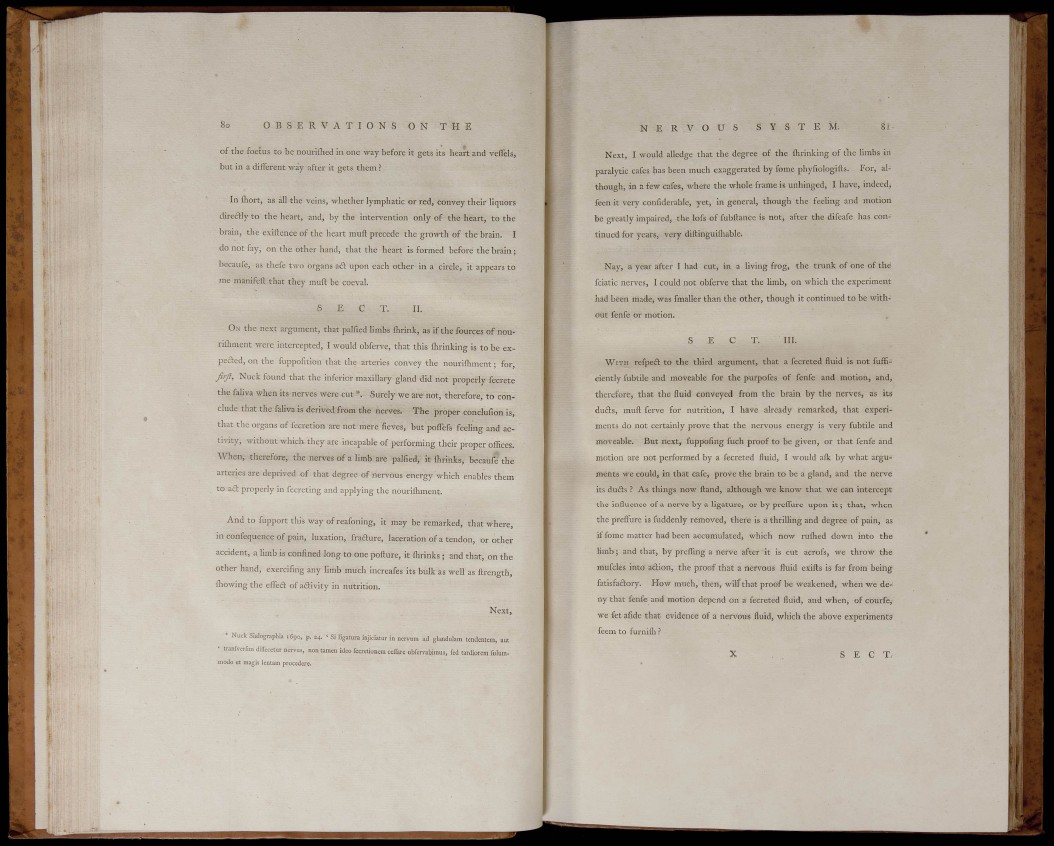
BJII S I I ' rr-
Pipi I ti '
80 O B S E R V A T I O N S ON THE
of the foetus to be nourillied in one way before it gets its heart and veflelsj
but in a different way after it gets them ?
In fliort, as all the veins, whether lymphatic or red, convey their liquors
direftly to the heart, and, by the intervention only of the heart, to the
brain, the cxiftence of the heart muft precede the gro%vth of the brain. I
do not fay, on the other hand, that the heart is formed before the brain ;
bccaufe, as thefe two organs aft upon each other in a circle, it appears to
me manifeft that tliey muft be coeval.
S E C T . II.
O.M the next argument, that palfied hmbs ihrink, as if the fources of nounflmient
were intercepted, I would obfervc, that this fluinking is to be expeaed,
on the fuppofition that the arteries convey the nouriihment ; for,
JirJl, Nuck found that the inferior maxUIaiy gland did not properly fecrete
the faliva when its nerves were cut *. Surely we are not, therefore, to conclude
that the faliva is derived from the nerves. The proper condufion is,
that the organs of fccretion are not mere fieves, but poffefs feeling and activity,
without which tliey are incapable of performing their proper offices.
When, therefore, the nerves of a limb are palfied, it ihrinks, becaufe the
arteries are deprived of that degree of nervous energy which enables them
to aa properly in fecrcting and applying the nourifliment.
And to fupport this way of reafoning, it may be remarked, that where,
in confequence of pain, luxation, frafture, laceration of a tendon, or other
accident, a limb is confined long to one pofture, it flirinks ; and that, on the
other hand, exercifing any limb much increafes its bulk as well as ftrength,
fliowing the efFefl of aaivity in nutrition.
Next,
• Nuck Shlographia ,690, p. 24. • Si ligBlura injkiatnr in n ï „ „ m ad glandd.m lendmlcni, aut
• traniwrfim d i fcemr nervui, „on tamsn ideo fcaetiooera eelTare obfervabimus, fed tardiorem folummodo
et niagis lentam procedere.
N E R V O U S SYSTEM; $f.-
Next, I would alledge that the degree of the ilirinking of tlie limbs in
paralytic cafcs has been much exaggerated by fome phyfiologifts. For, although,
in a few cafes, where the whole frame is unhinged, I have, indeed,
feen it very confiderable, yet, in general, though the feeling and motion
be greatly impaired, the lofs of fubilancc is not, after the difeafe has continued
for years, very diftinguifiiable.
Nay, a year after I had cut, in a living frog, the trunk of one of the
fciatic nerves, I could not obferve that the hmb, on which the experiment
had been made, was fmaller than the other, though it continued to be without
fenfe or motion.
E T . III.
WITH refped to the third argument, that a fecreted fluid is not fufficiently
fubtile and moveable for the purpofes of fenfe and motion, and,
therefore, that the fluid conveyed from the brain by the nerves, as its
duds, muft ferve for nutrition, I have already remarked, that experiments
do not certainly prove that the nervous energy is very fubtile and
moveable. But next, fuppofing fuch proof to be given, or that fenfe and
motion are not performed by a fecreted fluid, I would afk by what arguments
we could, in that cafe, prove the brain to be a gland, and the nerve
its duds ? As things now ftand, although we know that we can intercept
the influence of a nerve by a ligature, or by prelTure upon it; that, when
the preffure is fuddenly removed, there is a thrilling and degree of pain, as
if fome matter had been accumulated, which now ruihed down into the
limb; and that, by prefTmg a nerve after it is cut acrofs, we throw the
mufcles into adion, the proof that a nervous fluid exifts is far from being
fatisfadory. How much, then, wilf that proof be weakened, when we deny
that fenfe and motion depend on a fecreted fluid, and when, of courfe,
we fet afide that evidence of a nervous fluid, which the above experiments
feem to furnifli ?
X S E C T .
r
M